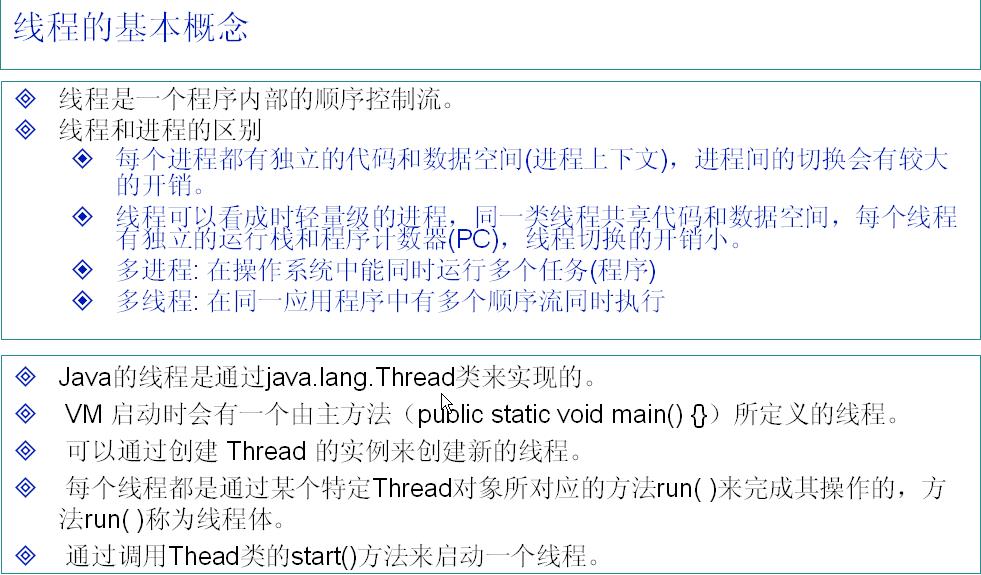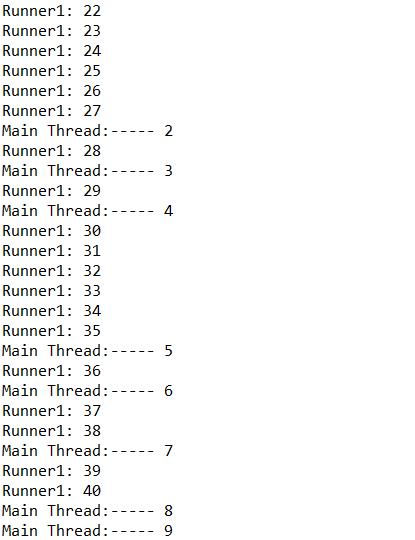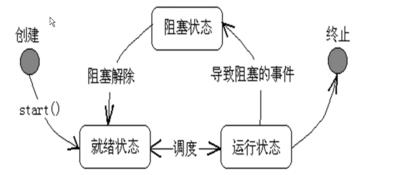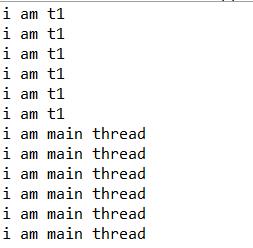java多线程 线程的基本概念
Posted 有点懒惰的大青年
tags:
篇首语:本文由小常识网(cha138.com)小编为大家整理,主要介绍了java多线程 线程的基本概念相关的知识,希望对你有一定的参考价值。
一、线程的基本概念:

线程是一个程序里面不同的执行路径。
程序里面不同的执行路径,每一个分支都是一个线程。
进程:静态的概念。机器上的一个class文件,机器上的一个exe文件,这叫一个进程。
机器里面实际上运行的都是线程。
window等。linux等都是多进程,多线程的系统。
CPU的执行是这样的:
CPU速度比较快,一秒钟算好几亿次,它把自己的时间分成一个一个的小时间片,这个时间片我执行你一会,再执行他一会,虽然有几十个线程,
没关系,执行这个一会,执行那个一会,挨着排的都执行一遍,但是对我们人来说,因为它速度太快了,你看起来就好像好多线程在同时执行一样。
但实际上,在一个时间点上, 这个CPU只有一个线程在运行。
如果机器是双CPU,或者是双核,那么确实是多线程。
二、线程的启动和创建:

例子1:实现Runnable接口:
package com.cy.thread; public class TestThread1 { public static void main(String[] args) { Runner1 r = new Runner1(); Thread t = new Thread(r); //启动一个线程,线程启动必须调用Thread类的start()方法 //start方法会通知cpu,我现在有个新线程了啊,已经准备好了,您老人家什么时候有时间赶紧给我点时间片。 t.start(); for(int i=0; i<100; i++){ System.out.println("Main Thread:----- " + i); } } } /** * 实现了Runnable之后,jdk就知道了,这是一个线程类。 */ class Runner1 implements Runnable{ @Override public void run() { for(int i=0; i<100; i++){ System.out.println("Runner1: " + i); } } }
console:

例子2:继承Thread类:
package com.cy.thread; public class TestThread1 { public static void main(String[] args) { Runner1 r = new Runner1(); r.start(); for(int i=0; i<100; i++){ System.out.println("Main Thread:----- " + i); } } } class Runner1 extends Thread{ @Override public void run() { for(int i=0; i<100; i++){ System.out.println("Runner1: " + i); } } }
三、线程的状态转换:

new Thread()一个线程之后,不会马上执行而是进入就绪状态,因为cpu很忙,可能正在执行其他程序;
等到cpu有空了,cpu分配时间片执行(调度)这个Thread一会;Thread进入运行状态;
当cpu分配给这个Thread的时间片用完了,或者其他原因故障等,Thread不再执行,阻塞,再次进入就绪状态;
直到这个Thread的程序执行完毕;终止。
四、线程控制的基本方法:

isAlive(): 判断线程是否还活着,即线程是否还未终止;就绪、运行、阻塞叫活着。终止了就死了。线程创建完还没启动那也是死的。
getPriority() 获得线程的优先级数值;优先级越高的线程获得的cpu执行的时间越多。
setPriority() 设置线程的优先级数值;
Thread.sleep() 将当前线程睡眠指定毫秒数。
join() 合并某个线程。
yield() 高风亮节,让出cpu,让其他的线程执行,而自己进入就绪状态。
wait() 当前线程进入对象的wait pool;
notify、notifyAll() 唤醒对象的wait pool中的一个/所有等待线程。
五、sleep方法:

package com.cy.thread; import java.util.Date; public class TestInterrupt { public static void main(String[] args) { MyThread thread = new MyThread(); thread.start(); try { /** * 在哪个线程里面调用sleep方法,就让哪个线程睡眠。 */ Thread.sleep(10000); } catch (InterruptedException e) { e.printStackTrace(); } /** * interrupt()方法:thread线程在睡眠的时候,将它打断。 * 这里为了例子演示,让子线程结束。 * 但这不是让子线程结束的最好方法。 */ thread.interrupt(); } } class MyThread extends Thread{ @Override public void run() { while(true){ System.out.println("==="+new Date()+"==="); try { sleep(1000); } catch (InterruptedException e) { return; } } } }
console打印:

上面的程序提供一个结束Mythread线程的方法:

/** * 提供一个让线程结束的方法: * thread.flag = false; run()方法就不再执行了,run方法一结束,线程就结束了。 */ class MyThread2 extends Thread{ boolean flag = true; @Override public void run() { while(flag){ System.out.println("==="+new Date()+"==="); try { sleep(1000); } catch (InterruptedException e) { return; } } } }
六、join方法:

package com.cy.thread; public class TestJoin { public static void main(String[] args) { MyThread2 t1 = new MyThread2("t1"); t1.start(); try { /** * 将t1线程合并到main线程,和main线程一块执行。 */ t1.join(); } catch (InterruptedException e) { e.printStackTrace(); } for(int i=0; i<=5; i++){ System.out.println("i am main thread"); } } } class MyThread2 extends Thread{ MyThread2(String s){ super(s); } @Override public void run() { for(int i=0; i<=5; i++){ System.out.println("i am " + getName()); try{ sleep(1000); }catch(InterruptedException e){ return; } } } }

七、yield方法:
执行到某一个点的时候,让出CPU,其他的线程有机会执行,不要说老让我自己一个人占着;
但是我就让一下,不是说从此我就不再执行了;

package com.cy.thread; public class TestYield { public static void main(String[] args) { //可以使用同一个线程类,new两个线程。 MyThread3 t1 = new MyThread3("t1"); MyThread3 t2 = new MyThread3("t2"); t1.start(); t2.start(); } } class MyThread3 extends Thread{ MyThread3(String s){ super(s); } @Override public void run() { for(int i=0; i<=100;i++){ System.out.println(getName() + ": " +i); if(i%10 == 0){ yield(); } } } }
观察输出,可以看到,每当被10整除后,下一个输出的一定是另外一个线程的。
八、线程的优先级:
Java提供一个线程调度器来监控程序中启动后进入就绪状态的所有线程。
线程调度器按照线程的优先级决定应调度哪个线程来执行。
线程的优先级用数字表示,范围从1-10,一个线程默认的优先级是5;
Thread.MIN_PRIORITY = 1;
Thread.MAX_PRIORITY = 10;
Thread.NORM_PRIORITY = 5;
使用下述方法获得或设置线程对象的优先级:
int getPriority();
void setPriority(int newPriority);

package com.cy.thread; public class TestPriority { public static void main(String[] args) { Thread t1 = new Thread(new T1()); Thread t2 = new Thread(new T2()); t1.setPriority(Thread.NORM_PRIORITY + 3); t1.start(); t2.start(); } } class T1 implements Runnable{ @Override public void run() { for(int i=0; i<1000; i++){ System.out.println("T1: " + i); } } } class T2 implements Runnable{ @Override public void run() { for(int i=0; i<1000; i++){ System.out.println("----T2: " + i); } } }
可以看到,t1得到cpu执行的时间片多,开始打印的都是t1,少部分t2。等到t1执行完了,才开始都是t2.
---------------
以上是关于java多线程 线程的基本概念的主要内容,如果未能解决你的问题,请参考以下文章
